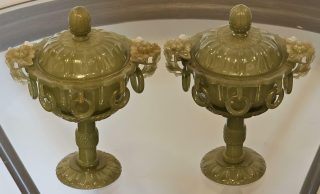Hi Jon. I recently read your article on the “Fat Man” Chinese Silver Coin. The article reminded me of these two Chinese items my grandparents had. They were Protestant Missionaries to China and Mongolia around 1910. Some of the items they were given in China we now have. Among the items are these. I can tell you that the glass is not broken, they stand 7 inches tall and are quite old. My grandparents treasured them and had them in their breakfront since I was a child. I’m now 81! What can you tell me about them? Are they valuable?
Edward / Pomona
Let me start off with a bit of good news. Your beautiful pair of Chinese Qing Dynasty covered jars are not made of glass, as you may believe. They are intricately carved green jade and quite valuable. A word about jade. Jade is actually a two-pronged term used for decorative rocks used for jewelry and other objects de vertu. Jade can actually be one of two different materials. Either nephrite or jadeite. Your covered jars are the latter. Jadeite is the more precious type of jade. Most gem-quality jadeite comes from northern Myanmar. To give a basic definition, jadeite is micro crystalline interlocking growth of crystals and magnesium iron. The higher the iron content, the greener the color will be. Jadeite has about the same hardness as quartz. In addition, jade is tougher than diamond, but diamond is harder than jade. (Tougher vs. Hardness). Jade sits at number 7 on the Mohs hardness scale, where a diamond is at number 10. Yes, jade can be scratched. Therefore, great care should be taken to avoid scratches to your antique jade items. The Mohs scale, I just referred to, is an assessment of a gemstone’s ability to scratch a surface. You might associate hardness to be a feature of strength, something which can hardly break. But in the world of gemology, hardness doesn’t mean “hard” as we know it. To jewelers, hardness isn’t about the fragility of a gemstone, but more about its ability to withstand scratches. Now that we have a basic understanding of jade, let’s get back to your antique carved jade Chinese archaistic style circular covered bowls. First, they were produced in the third quarter of the nineteenth century. Each bowl features short, rounded sides, carved in low -relief panels, rising to a lipped ring, further flanked by wonderfully carved lotus flower heads. The covers are similarly carved with another band of panels and shaped handles at the top. Top quality skill and design. Now for the grand finale, and yes, more good news. The Asian antiques market is very strong at this time, in particular Chinese antiques and fine art. An additional plus, you own a matching pair. Most of the time when we encounter a pair, one is missing. It has long been broken up, damaged or lost to time. Only a single remains. Not in your case. Both are still together. Therefore, a current conservative value of these high-quality carved jade covered jars is $ 8,000 USD. Continue to take special care of these treasures.


You must be logged in to post a comment Login